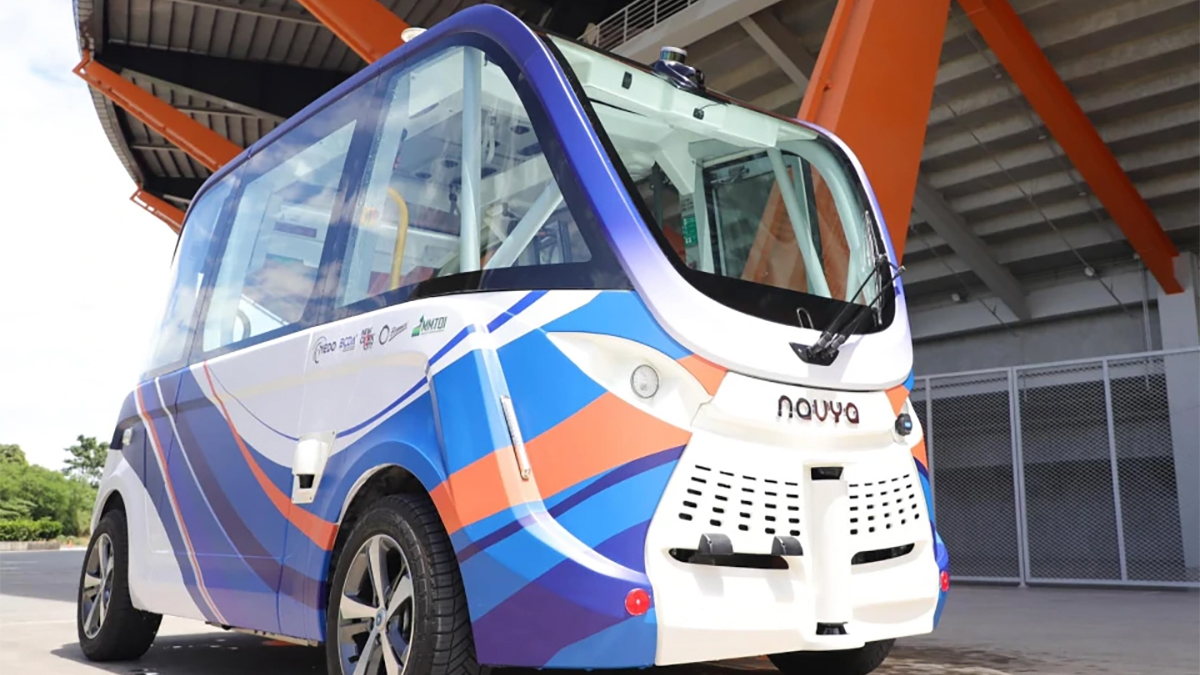LARISA E., who works at an out- sourcing company in the ClarkFreeport Zone, has become a regular passenger of the Navya self-driving bus, the country’s first publicly accessible autonomous mode of transportation.
Though the queues are long, the novel transportation is receiving a lot of attention—and testing—as the Japanese technology equipped, French developed autonomous bus is used daily on select routes within New Clark City, Clark Freeport Zone, and Clark International Airport. It is designed to serve as a “last mile” solution to connect key areas.
“The service is free until June next year, so many people want to take advantage of it and also make Instagram posts,’ Larisa said in Tagalog.
Launched last September 2024, the autonomous bus, developed by Navya, a French company specializing in autonomous and electric vehicles, operates without a driver, utilizing advanced sensors and navigation systems. It can accommodate up to 15 passengers—11 seated and 4 standing—and runs at a maximum speed of 25 km/h. The bus is designed to function continuously for approximately nine hours, providing a reliable mode of transport for commuters.
The autonomous bus service employs the Smart Mobility Operation Cloud (SMOC) system, which uses real-time data to optimize routes and schedules, ensuring efficient and responsive service. This technological integration aligns with the Bases Conversion and Development Authority’s (BCDA) vision to make New Clark City the country’s first sustainable, smart, and green city.
Pending fare collection guidelines from the Land Transportation Office and the Land Transportation Franchising and Regulatory Board (LTFRB), the autonomous bus runs 9 hours a day and could pave the way for broader adoption of autonomous and electric vehicles in the country.
Autonomous buses have been experimented on in various places all over the world.
According to Tom Stone of Traffic Technology International (TTi), the city of Hamburg, Germany, is leading the way in the transformation of public transportation with its ambitious Alike vehicle pilot project. Currently, the project is deploying 120 electric, autonomous shuttle buses that are providing on-demand rides throughout the city.
This innovative pilot is just the beginning, as the city plans to significantly scale up its fleet in the coming years. By 2027, Hamburg aims to have 800 such vehicles in operation, with a long-term goal of expanding the fleet to 2,000 autonomous electric shuttles by the end of the decade.
The Alike project is designed with safety as a top priority, ensuring that the system meets strict safety regulations. The project also has scalability in mind, with the goal of adapting the model to rural areas in addition to urban environments.
In the UK, a groundbreaking self-driving shuttle, designed to transport residents across Milton Keynes, is set to undergo testing on city roads next month. If the trials prove successful, the shuttle service could be available to the public as early as next year.
The vehicle, known as StreetCAV, is a ‘plug-and-play’ driverless shuttle developed through collaboration between several private and public sector organizations. The project involves key partners, including Smart City Consultancy (SMCCL), Milton Keynes City Council, Ohmio, CableFree, BT, and Electronics Computers and Systems (ECS). This initiative is part of the CAM Supply Chain UK program, which is funded by the Centre for Connected and Autonomous Vehicles (CCAV).
According to Kyodo News, in Haneda Innovation City, a commercial and business complex near the airport, self-driving buses also built by Navya started to provide free rides within the premises starting July this year. Looking very similar to the Clark City buses, the Haneda autonomous bus carries only 11 seating passengers along an 800-meter route at a maximum speed of 12 kilometers per hour. The vehicles’ operations are monitored remotely to ensure safety and efficiency.
Plans are also underway to expand the service, with the goal of introducing autonomous vehicles connecting Haneda Innovation City to the airport itself on a 3.9-kilometer round-trip route by 2026. This move is part of Japan’s broader efforts to address the acute labor shortages that have heavily impacted the transportation sector, including bus and taxi services. The government is actively promoting the use of self-driving vehicles as a solution to these challenges, signaling a significant step towards transforming Japan’s transportation infrastructure.
The project is a collaboration between Boldly Inc., a subsidiary of SoftBank Corp. specializing in autonomous driving, and Kajima Corp., a general contractor involved in managing the complex. In April 2024, the two companies became the first in the private sector to receive official approval from authorities to operate Level 4 autonomous vehicles for public use.
Level 4 autonomous driving, referred to as ‘high driving automation.’ It is considered to be fully autonomous driving, meaning there isn’t any need for human intervention. Included in Level 4 operation is that the human driver can still request control, and the car still has a cockpit, meaning it still has a steering wheel and other controls, but the car can handle the majority of driving situations independently.
Though the EU has been proactive in regulating automated vehicles, with level 3 automated vehicles, which require a safety driver, currently permitted on public roads. However, the EU is working towards enabling Level 4 autonomy by 2025.
It is expected that by 2030, in the more advanced countries in the world, autonomous public transport will become the norm, but overcoming issues like complex traffic situations, weather conditions, and ensuring safety standards are crucial for widespread implementation. Moreover, governments need to establish clear guidelines regarding operation, liability, and even data privacy for autonomous public vehicles.





